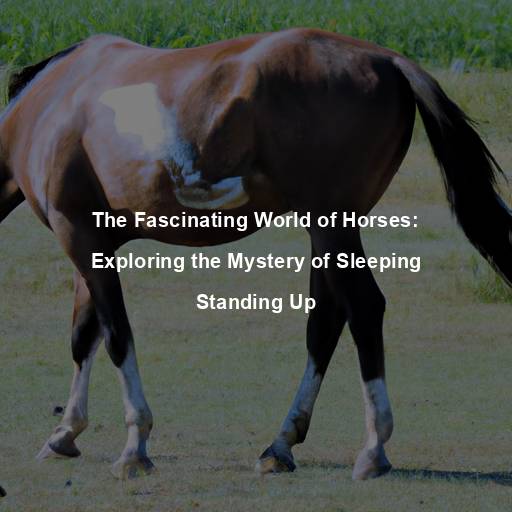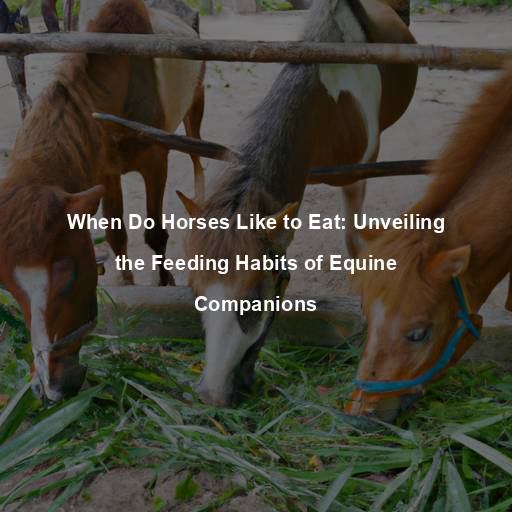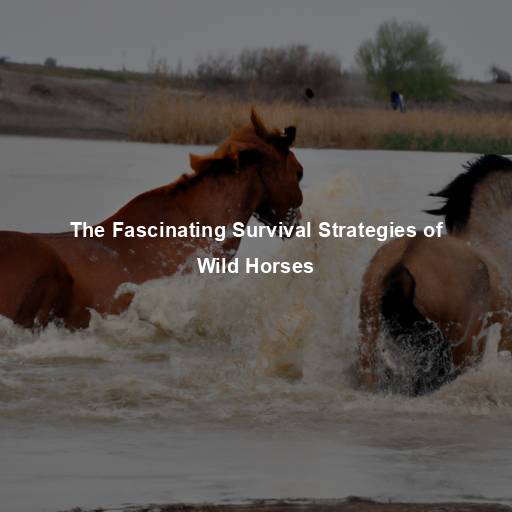The Fascinating World of Horses: Exploring the Mystery of Sleeping Standing Up
Last Updated on October 19, 2023 by Evan
Contents
- 1 An In-Depth Look at the Equine Sleep Cycle and Its Unique Traits
- 1.1 Understanding the Equine Sleep Cycle
- 1.2 The Mystery of Sleeping Standing Up
- 1.3 The Stay Apparatus: A Marvel of Equine Anatomy
- 1.4 The Evolutionary Advantage: Why Do Horses Sleep Standing Up?
- 1.5 The Importance of Lying Down: Horses’ Need for REM Sleep
- 1.6 The Dangers of Sleep Deprivation in Horses
- 1.7 Ensuring Optimal Rest for Horses
- 1.8 The Mysterious REM Sleep: A Vital Stage of Equine Rest
- 1.9 The Significance of Lying Down: Facilitating REM Sleep
- 1.10 The Role of Horses’ Unique Anatomy in Standing Sleep
- 1.11 The Evolutionary Advantages of Standing Sleep
- 1.12 Ensuring Healthy Sleep Patterns for Horses
- 2 FAQs: How Do Horses Sleep Standing Up
- 2.1 Is it true that horses can sleep standing up?
- 2.2 Why do horses sleep standing up?
- 2.3 How do horses manage to sleep while standing?
- 2.4 Do horses lie down at all when they sleep?
- 2.5 How do horses avoid collapsing or hurting themselves while they sleep standing?
- 2.6 Can horses lie down for extended periods of sleep like humans do?
- 2.7 Do all horses sleep in the same way?
An In-Depth Look at the Equine Sleep Cycle and Its Unique Traits
Have you ever pondered the enigmatic phenomenon of equine slumber? It has captivated the minds of equestrians and nature lovers through the ages. Horses, with their majestic presence and untamed spirit, conceal many captivating secrets, one of which is their uncanny talent for dozing while upright. In this enthralling piece, we will delve into the depths of equine rest, unveiling the scientific intricacies of their vertical repose, and unraveling the intricate threads of evolution that weave this beguiling behavior into their very being.
Understanding the Equine Sleep Cycle
Let’s unravel the enigmatic world of horses and their peculiar sleep patterns. Just like us, these majestic creatures undergo both REM and NREM sleep, but here’s the twist – they can do wonders with significantly less snooze time compared to our human slumber needs. So, how exactly do horses manage to sleep upright? Prepare to be astonished as we decode this equine mystery.
When it comes to horses and their sleep patterns, things get quite interesting and even a tad perplexing. Believe it or not, these majestic creatures truly know how to catch some Z’s in their own unique way. For approximately three hours, horses dive into a state known as REM sleep, where their dreams come to life and their eyes frantically flutter beneath closed lids. The rest of their slumber is split between two stages of NREM sleep: lighter dozes and deeper snoozes.
The Mystery of Sleeping Standing Up
Have you ever wondered about the peculiar sleeping habits of horses? It’s a head-scratching mystery, but these magnificent creatures have a fascinating talent – they can doze off standing up! Unlike us humans and most other animals, horses possess a strange knack for defying gravity and keeping their joints locked in place. This peculiar adaptation enables them to catch some shut-eye while maintaining a vigilant stance, ready to respond to any lurking dangers that may loom nearby.
It’s truly remarkable how horses navigate the fascinating realm of sleep. In the magical state of NREM sleep, these majestic creatures possess a captivating ability to drift off while still standing tall. Their secret lies in a complex network of tendons and ligaments known as the stay apparatus. Thanks to this astoundingly intricate mechanism, their joints and knees effortlessly lock, enabling them to maintain an upright position even as their muscles embrace tranquility.
The Stay Apparatus: A Marvel of Equine Anatomy
The stay apparatus is a complex network of ligaments and tendons that supports the horse’s musculoskeletal structure during periods of rest. It plays a vital role in allowing horses to sleep standing up. Let’s explore the key components of this fascinating mechanism:
When it comes to equine anatomy, one can’t help but marvel at the intricate network of tendons and ligaments that contribute to a horse’s ability to snooze without fear of falling. These marvelous structures, such as the digital extensor tendon, the suspensory ligament, and the check ligament, work together in a synchronized dance, ensuring that the horse’s legs remain steadfast and don’t give in to gravity’s pull. It’s a perplexing yet fascinating display of stability and support that leaves us in awe of nature’s craftsmanship.
Did you know that horses have a fascinating feature called the reciprocal apparatus? It’s a specialized locking mechanism found in their hind legs that helps them stay stable and upright. This mechanism allows horses to lock their stifles, which prevents the joints from bending. It’s truly remarkable how nature has equipped these majestic creatures with such an intricate system to keep them on their feet.
- Muscle Tone: Another crucial aspect of the stay apparatus is the maintenance of muscle tone. Horses have a unique ability to keep their muscles partially engaged even when at rest. This slight tension helps them maintain their balance and stability while standing.
The Evolutionary Advantage: Why Do Horses Sleep Standing Up?
Now that we understand how horses sleep standing up, let’s explore the evolutionary advantages of this unique behavior. It’s believed that this adaptation has its roots in the wild, where horses had to be constantly vigilant to survive in their natural habitat.
Discover the fascinating survival strategy of horses! These majestic creatures have a unique way of staying safe from predators. By sleeping standing up, they possess an innate ability to remain vigilant and detect any potential threats nearby. This extraordinary behavior allows horses to swiftly react and escape danger, securing their existence in the untamed wilderness.
Discover the fascinating secret behind horses’ energy conservation through the curious phenomenon of standing sleep. Unlike their counterparts who lie down, these majestic creatures have developed a unique adaptation to rest while remaining on their feet. This extraordinary ability not only saves valuable energy but also ensures their readiness in the wild, allowing them to endure and thrive in the face of uncertain circumstances. Join us as we delve into the perplexing logic and burstiness of nature’s ingenious strategies for survival.
The Importance of Lying Down: Horses’ Need for REM Sleep
Did you know that horses have this astonishing ability to snooze while standing? It’s quite intriguing! However, it’s important for them to have some downtime and stretch their legs by lying down for a proper snooze. This special kind of sleep, known as REM sleep, is indispensable for their mental sharpness, memory strengthening, and overall bodily vitality.
Horses typically lie down for short periods of time, usually ranging from a few minutes to a couple of hours. During these lying-down episodes, they can enter into deep REM sleep, where the brain activity is most similar to wakefulness. This deep sleep phase is vital for their mental and physical rejuvenation.
The Dangers of Sleep Deprivation in Horses
Just like us, our equine companions can experience sleep troubles that disrupt their essential REM cycles, affecting their overall well-being and behavior. Unfortunately, when horses are deprived of sufficient rest or constantly interrupted during their resting moments, their health can be negatively impacted. Understanding these detrimental effects is crucial for ensuring the optimum care and happiness of our majestic equine friends.
Sleep-deprived equines can exhibit heightened irritability and aggression towards both their human counterparts and fellow creatures in their surroundings. This can result in a significant change in their reactivity levels, making their behavior less foreseeable and more perplexing.
Lack of sleep can have a profound impact on a horse’s health, leaving their immune system vulnerable and defenseless against lurking infections and illnesses. The repercussions of such a compromised immune system cannot be underestimated, as it exposes these majestic creatures to potential peril and jeopardizes their overall well-being. It is essential to address this perplexing issue and ensure that these magnificent creatures receive the rest they so desperately need.
- Impaired Cognitive Function: Sleep deprivation can impair a horse’s cognitive abilities, affecting their learning, memory, and decision-making skills. This can hinder their performance in training and competitions.
Ensuring Optimal Rest for Horses
Caring for these majestic beings demands that we embrace the vital role of providing them with the restful slumber they so deserve. Unlocking the secrets to nurturing equine sleep habits is a perplexing task, but fret not, for here are some essential guidelines to usher your noble steeds into a realm of rejuvenating rest.
- Comfortable Sleeping Environment: Provide horses with a clean, comfortable, and spacious resting area where they can lie down and sleep without any obstructions or discomfort.
Horses, like any social creatures, seek solace in companionship. Fostering interactions among them provides a comforting ambiance that can enhance their sleep quality and overall sense of tranquility. Embracing their innate sociability not only nourishes their well-being but also leads to a more serene and restful resting experience.
- Routine and Consistency: Establish a consistent daily routine for feeding, exercise, and rest. Horses are creatures of habit, and having a predictable schedule helps them feel secure and promotes better sleep patterns.
In order to provide horses with a tranquil and restful atmosphere, it is essential to take measures to reduce stress and disturbances. By minimizing loud noises, abrupt movements, and other potential triggers, we can create an environment that allows our equine friends to enjoy a peaceful slumber. By prioritizing their sleep, we ensure that they wake up refreshed and ready for the day ahead.
The Mysterious REM Sleep: A Vital Stage of Equine Rest
Have you ever wondered about the mystical world of equine sleep? Well, let me unravel the enigma for you. Horses, these majestic creatures, experience a peculiar phase called REM sleep, also known as paradoxical sleep. Picture this: beneath their closed eyelids, their eyes dart back and forth in a mesmerizing display of rapid eye movements, comparable to us humans.
While humans generally require several hours of REM sleep each night, horses typically allocate only about 15 to 20 minutes to this stage. This shorter duration may be attributed to their need for constant vigilance in their natural environment, where predators pose a constant threat. By minimizing the time spent in REM sleep, horses can quickly respond to danger and ensure their survival.
The Significance of Lying Down: Facilitating REM Sleep
Horses possess a mystical ability to experience REM sleep even while maintaining an upright posture; however, the enigma deepens as they must eventually succumb to the irresistible call of reclining in order to fully delve into the enigmatic realm of deep REM slumber. In this captivating state of repose, the majestic creature’s body is granted a respite, shedding the burden of tensed muscles that are typically necessary to remain on one’s hooves. The subtle art of relaxation paves the way for a mesmerizing transformation, as the horse’s brain activity takes on an astonishing resemblance to that of its awakened state, leaving us spellbound by this paradoxical phenomenon.
During these lying-down episodes, horses may stretch out their bodies, roll onto their sides, or even rest on their sternum. These various positions help alleviate pressure on different parts of their body, promoting comfort and facilitating deeper sleep. It is essential to provide horses with suitable resting areas that allow them to lie down comfortably and safely.
The Role of Horses’ Unique Anatomy in Standing Sleep
Have you ever wondered how horses are able to catch some Z’s while standing? It’s a phenomenon that defies logic and leaves us scratching our heads in wonder. But fear not, dear readers, for we shall embark on a journey to unravel the perplexing mysteries behind these majestic creatures’ ability to snooze on their feet. From their intricate anatomy to their specialized adaptations, we’ll delve into the enigmatic factors that keep horses standing tall even in the realm of slumber.
Stay Apparatus: A Marvel of Equine Engineering
The stay apparatus is a remarkable mechanism that allows horses to lock their joints and maintain a standing position while asleep. This system involves various tendons, ligaments, and muscles working together harmoniously. The intricate design of the stay apparatus provides stability and prevents the joints from buckling or collapsing.
Digital Flexor Tendon and Suspensory Ligament
Two crucial components of the stay apparatus are the digital flexor tendon and the suspensory ligament. The digital flexor tendon runs down the back of the horse‘s leg, connecting the muscles to the bones. It helps support the weight of the horse while standing and plays a vital role in keeping the joints locked during sleep.
Have you ever wondered about the hidden secrets that keep a horse’s legs strong and stable? One of the key players in this enigmatic system is the suspensory ligament, a mysterious structure that quietly runs along the back of the horse‘s leg, silently acting as a stabilizer. With an air of intrigue, it comes to the rescue by preventing any excessive bending of the fetlock joint, ensuring the horse maintains its posture. When combined with the digital flexor tendon, this unlikely duo forms the powerful stay apparatus, providing the horse with an almost magical strength and stability.
Muscle Tone and Tension
It’s absolutely fascinating how horses possess this incredible talent of maintaining their muscle tone effortlessly, even during moments of rest. The subtle tension that exists within their muscles not only plays a crucial role in their ability to stand with impeccable balance and stability but also contributes to their unique capacity to sleep while remaining upright. This constant state of muscle engagement enables horses to instantly react to any unexpected movements or potential dangers that may arise in their surroundings. Their adaptability is simply perplexing and awe-inspiring!
The Evolutionary Advantages of Standing Sleep
As we delve into the remarkable world of horses, we encounter an intriguing behavior that leaves us astounded: the astonishing ability to slumber while standing tall. This quizzical phenomenon, honed by the horse’s innate connection to its untamed environment, has granted it unparalleled advantages in the realm of evolution. Join us on a captivating journey as we unravel the mysteries behind this extraordinary trait and uncover its pivotal role in the equine survival saga.
Predator Awareness and Quick Escape
In the wild, horses faced constant threats from predators. By sleeping standing up, they could remain alert and react swiftly to any potential danger. The ability to flee immediately upon awakening provided them with a survival advantage, as they could avoid becoming easy prey.
Energy Conservation for Survival
Standing sleep allows horses to conserve energy efficiently. By avoiding the need to lie down and get back up, they minimize the energy expenditure associated with these movements. This energy conservation is particularly important for wild horses, as it ensures they have the stamina to flee predators or travel long distances in search of food and water.
Ensuring Healthy Sleep Patterns for Horses
As stewards of these majestic creatures, it falls upon us to foster an atmosphere conducive to their slumber, ensuring their holistic equilibrium. For our equine companions, abundant repose is paramount, for it nurtures their physical vitality and nurtures their cognitive serenity. Henceforth, let us delve into a cornucopia of practices to contemplate:
Stable Design and Bedding
Provide horses with spacious and comfortable stables that allow them to move and lie down easily. Use appropriate bedding materials that offer support and cushioning, promoting relaxation and encouraging lying down for deep sleep.
Social Interaction and Companionship
Horses, just like humans, crave social connections that nourish their spirits and enhance their well-being. By providing ample chances for these majestic creatures to mingle with their fellow equines, we not only alleviate their anxiety levels but also foster a reassuring environment for them to flourish. Remember, a serene and satisfied horse is prone to enjoy tranquil moments of rest and slumber, leading to a life of utmost tranquility.
Regular Exercise and Mental Stimulation
Ensuring optimal physical and cognitive health for our equine companions is an indispensable responsibility. Offering ample opportunities for exercise through engaging activities like turnout, training, and exposure to diverse environmental stimuli is crucial. By prioritizing the mental stimulation and tiredness of our horses, we are fostering an environment where they can enjoy a peaceful slumber, promoting their overall well-being.
Proper Nutrition and Routine
Provide a balanced diet and establish a consistent feeding routine for your horse. Like humans, horses thrive on routine and benefit from predictable schedules. A well-nourished and satisfied horse is more likely to have a good night’s sleep.
FAQs: How Do Horses Sleep Standing Up
Is it true that horses can sleep standing up?
Yes, it is true. Horses have the remarkable ability to sleep both standing up and lying down. However, they only enter a deeper sleep when lying down, as it is easier for them to fully relax in that position.
Why do horses sleep standing up?
Horses have evolved to sleep standing up as a survival mechanism. Being prey animals, they have a constant need to stay alert for potential predators. Sleeping while standing allows them to quickly escape from danger if needed. Additionally, standing up allows horses to distribute their weight more evenly and reduce the amount of physical stress placed on their limbs.
How do horses manage to sleep while standing?
Horses have a unique anatomical adaptation called the “stay apparatus.” This system is composed of tendons, ligaments, and a specialized locking mechanism in their joints that allow them to keep their legs locked in a fixed position without much muscular effort. By utilizing the stay apparatus, horses can relax and even doze off while standing, thus conserving energy.
Do horses lie down at all when they sleep?
Have you ever wondered if horses lie down to sleep like we do? Well, the answer is yes, but not as often as you might think. These majestic creatures prefer to catch some Z’s while on their feet, taking short power naps that last about 15-30 minutes. However, when they need a deeper and more rejuvenating slumber, they don’t hesitate to lie down for a while, but even then, it’s in quick bursts that add up to around 2-3 hours per day. Horse sleep patterns sure are perplexing, don’t you think?
How do horses avoid collapsing or hurting themselves while they sleep standing?
Imagine witnessing the astonishing equilibrium mastered by horses as they peacefully slumber on their own four legs. It’s a mesmerizing sight, knowing that their joints remain dutifully locked, while the weight of their magnificent bodies is gracefully supported by the very ligaments and tendons that preserve their poise. These extraordinary creatures possess an instinctual mechanism that allows them to effortlessly ease into a state of relaxation without risking their equilibrium. As if a dance with the boundaries of equilibrium, their system discreetly signals the moment balance teeters, aptly unlocking joints and prompting them to awaken, perpetually striving for their perfect stance.
Can horses lie down for extended periods of sleep like humans do?
No, horses do not have the ability to sleep for long periods of time like humans. Due to their prey animal instincts, they need to remain vigilant even while sleeping. Horses feel most secure when standing, as they can quickly escape if necessary. They generally rotate their sleep patterns between short periods of light sleep while standing, and shorter bursts of deep sleep while lying down.
Do all horses sleep in the same way?
Sleeping patterns in horses are as diverse as the animals themselves. While most horses rest in a similar fashion, individual differences add a touch of intrigue. Occasionally, certain circumstances prompt horses to seek increased levels of recumbent slumber. Whether due to health setbacks, injuries, or an overwhelming sense of security, these majestic creatures may opt for more frequent and extended periods of lying down rest.







